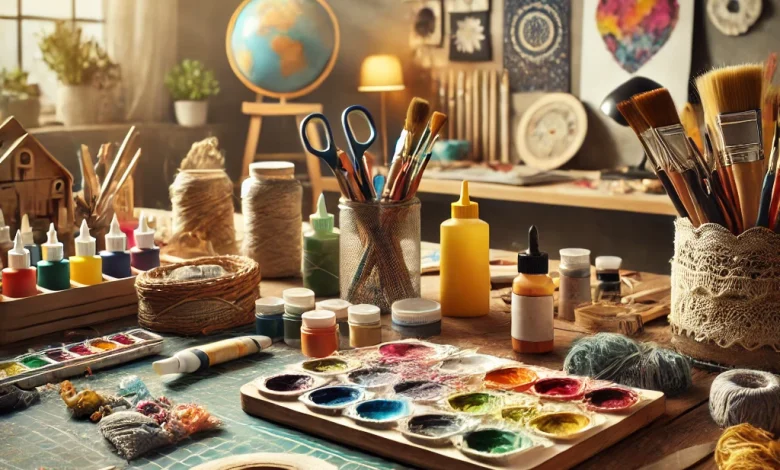How to Make Anything: A 10-Step Guide to Learning, Creating, and Sharing DIY Projects

Table of Contents
Introduction
Making things is a wonderful way to express creativity, develop new skills, and create something unique and valuable. Whether it’s a craft, a piece of furniture, or a homemade gadget, learning how to make things can be a fun and rewarding experience. Engaging in DIY projects allows you to personalize your creations, save money, and even develop a profitable hobby. With the right tools, materials, and guidance, anyone can learn how to make amazing things from scratch.
1. Choosing What You Want to Make
Before you start any DIY project, the first step is deciding how to make something that aligns with your interests, needs, and available resources. Knowing how to make the right choice will ensure that your project is both enjoyable and practical. Here are some factors to consider when selecting what to create:
Identify Your Interests and Skills
- Think about what excites you—whether it’s woodworking, painting, sewing, or electronics.
- Assess your current skill level and learn how to make projects that match your experience.
- Start with simpler projects if you’re a beginner and gradually take on more complex tasks.
Consider Practicality and Usefulness
- Decide how to make something that serves a functional purpose in your daily life.
- Choose projects that solve a problem, like organizing solutions, home decor, or personalized gifts.
- Research how to make high-quality items that will last longer and provide real value.
Check Available Resources and Budget
- Look at the materials and tools you already have and learn how to make the best use of them.
- Research affordable alternatives and find how to make cost-effective substitutions.
- Plan a budget to avoid overspending and still achieve great results.
Seek Inspiration and Guidance
Look at project reviews to see what challenges others faced and learn how to make improvements in your own approach.
Browse websites, DIY forums, and video tutorials to discover how to make creative and unique projects.
Follow experienced DIYers to gain insights on how to make your work easier and more efficient.
Step-by-Step Approach
- Start by researching detailed instructions from reliable sources, such as books, tutorials, or online guides.
- Watch video demonstrations to visualize the process and understand techniques more clearly.
- Break the project down into smaller, sequential steps and create a checklist to track your progress.
- Gather all materials and tools before starting each step to maintain an uninterrupted workflow.
- If the project is complex, consider sketching or diagramming the steps for better clarity.
Learn from Experts
- Seek guidance from experienced DIYers through blogs, online forums, and YouTube tutorials.
- Join DIY communities or social media groups where you can ask questions and share experiences.
- Look for workshops, webinars, or local classes to gain hands-on experience and expert insights.
- Read reviews and feedback on different methods to determine which approach works best for your project.
- Consider reaching out to mentors or skilled individuals who can provide personalized advice and troubleshooting tips.
Patience and Practice
Set realistic expectations and give yourself the freedom to learn at your own pace.
Understand that mastering DIY skills takes time and repetition. Don’t be discouraged by mistakes—view them as learning opportunities.
Start with simpler projects to build confidence before attempting more complex creations.
Keep a record of your progress, noting what worked well and what could be improved for future projects.
Experiment with different techniques to find what best suits your style and skill level.
- Identify Your Interests and Needs: Choose a project that excites you. If you love home decor, consider how to make custom wall art. If you need functional items, learn how to make storage solutions.
- Consider Skill Level: Beginners should start with simple projects before advancing to complex ones.
- Available Resources: Assess the materials and tools you already have. If you’re on a budget, look for DIY projects that require minimal investment.
- Research Popular DIY Ideas: Browse social media, DIY blogs, and video tutorials to find trending projects and innovative ideas for how to make something useful. Make a Checklist
- Write down all the essential supplies and tools required for the project.
- Organize the list into categories such as materials, adhesives, fasteners, and finishing supplies.
- Consider alternative materials if certain items are unavailable or expensive.
- Find Cost-Effective Sources
- Search for affordable materials online, at local craft stores, hardware shops, and even second-hand stores.
- Check for seasonal discounts, bulk deals, or loyalty programs at stores that sell DIY supplies.
- Explore repurposing or upcycling materials from old projects, household items, or discarded materials.
- Consider borrowing tools from friends, family, or local tool-lending libraries instead of purchasing expensive equipment.
- Prepare Your Workspace
- Set up a clean, well-lit, and ventilated workspace appropriate for your project.
- Organize tools and materials for easy access and efficient workflow.
- Use storage solutions like bins, shelves, and pegboards to keep everything in order.
- Safety First
- Always follow safety guidelines when using tools and handling materials.
- Use protective gear like gloves, masks, and goggles when necessary.
- Ensure your workspace has proper ventilation, especially when working with paints, adhesives, or chemicals.
- Read and follow instructions or manuals for tools and equipment before use.
- Keep a first-aid kit nearby in case of minor injuries. 4. Creating Your Project
Now comes the fun part—bringing your idea to life! Understanding how to make your chosen project successfully depends on following instructions carefully, handling challenges effectively, and working efficiently.
Follow Instructions Carefully
Stick to the steps outlined in your guide on how to make the item correctly.
Read through all instructions before starting to ensure you understand each phase.
Double-check measurements, cuts, and placements to avoid mistakes.
If using a pattern or blueprint, follow it precisely to achieve the best results.
Troubleshooting Issues
If something doesn’t go as planned, review tutorials on how to make corrections for common mistakes.
Identify potential issues such as incorrect measurements, weak joints, or improper finishing techniques.
Look for alternative methods or adjustments if an original step isn’t working.
Ask for advice from experienced DIYers in forums or video comment sections on how to make necessary fixes.
Efficiency Tips
Keep your workspace organized to make how to make processes smoother and quicker.
Arrange all tools within reach and maintain a clutter-free area for better focus.
Use time-saving techniques like pre-cutting materials, batching similar tasks, and setting up an assembly line for multi-step projects.
Work in a well-lit and ventilated area to ensure safety and precision.
5. Finishing Touches and Improvements
Enhancing your finished product is essential to make it look polished and professional. Knowing how to make a project truly stand out involves refinement, customization, and ensuring durability.
Refinement
Sand, paint, or polish your creation to achieve a smooth, clean, and professional look.
Learn how to make edges smoother and surfaces even by using proper finishing techniques.
Remove excess glue, dust, or any imperfections before applying final coatings.
If applicable, sew, stitch, or carve finer details to enhance the overall design.
Customization
Add personal touches to make your project unique, such as engraving, painting, or decorating.
Experiment with different colors, patterns, and materials to match your style.
Look up creative guides on how to make customized enhancements based on your preferences.
Incorporate embellishments like fabric accents, metal inlays, or hand-painted details.
Durability
Learn how to make your creation last longer by choosing high-quality materials and applying protective coatings.
Seal, varnish, or waterproof items to ensure they withstand wear and tear.
Use reinforcements, adhesives, or additional support structures for better durability.
Store and maintain your project properly to prevent damage over time.
6. Sharing and Showcasing Your Work
Once your project is complete, it’s time to share it with the world! Understanding how to make your work stand out through photography, social media, and even selling or gifting can enhance your DIY journey. Learning how to make a strong impression with your creations helps inspire others and opens new opportunities.
Photography and Videos
- Capture high-quality images and videos to highlight your craftsmanship.
- Learn how to make your projects look professional by using good lighting and clean backgrounds.
- Experiment with different angles and close-ups to showcase details.
- Record time-lapse or step-by-step videos demonstrating how to make similar projects.
- Use editing tools to enhance colors, adjust brightness, and add text overlays. Social Media and DIY Communities
- Sharing your DIY creations online can help you connect with like-minded individuals, gain inspiration, and even turn your hobby into a business. Learning how to make the most of social media and DIY communities will expand your reach and showcase your work effectively.
- Choose the Right Platforms
- Instagram: Great for visual storytelling. Learn how to make high-quality posts with well-lit photos and engaging reels.
- Pinterest: A perfect place to share step-by-step guides and inspiration boards on how to make unique projects.
- Facebook Groups: Join crafting communities where people exchange ideas, share tutorials on how to make different DIY projects, and offer feedback.
- YouTube & TikTok: If you enjoy making videos, record tutorials on how to make your projects and share them with a wider audience.
- Create Engaging Content
- Learn how to make engaging captions by describing your process, materials used, and challenges faced.
- Share behind-the-scenes content that shows how to make the project step by step.
- Post before-and-after images to highlight your craftsmanship.
- Experiment with different content types, such as time-lapse videos, tutorials, and interactive polls.
- Use Strategic Hashtags
- Use relevant hashtags like #DIY, #Handmade, #Crafting, and #HowToMake to improve visibility.
- Research trending hashtags in your niche to learn how to make your posts more discoverable.
- Mix broad and niche-specific hashtags to reach both large audiences and smaller, engaged communities.
- Engage with the Community
- Join online forums and groups where people discuss how to make similar projects.
- Comment on posts, ask questions, and offer advice to build relationships with fellow creators.
- Participate in crafting challenges or DIY contests to gain exposure and learn how to make your skills even better.
- Collaborate with other DIY enthusiasts to create joint content, such as guest blog posts or shared tutorials.
- Turning Engagement into Opportunities
- If you receive positive feedback, consider teaching others how to make similar creations through online courses or workshops.
- Monetize your work by learning how to make a brand presence through partnerships, sponsorships, or selling your crafts.
- Network with influencers and DIY experts to gain more visibility and opportunities in the crafting world.
Selling or Gifting
- If you enjoy crafting, consider turning it into a business by selling your items online.
- Research how to make a successful online store on platforms like Etsy, eBay, or Shopify.
- Price your creations based on material costs, time spent, and market demand.
- Create custom pieces by learning how to make personalized handmade gifts for special occasions.
- Package items attractively and include a thank-you note for a personal touch.
- If selling isn’t your goal, gifting handmade items can be a thoughtful way to show appreciation.
By understanding how to make your work shine through photography, social media, and thoughtful presentation, you can inspire others and potentially turn your passion into a rewarding endeavor. Whether you’re sharing for fun or looking into selling, knowing how to make your creations stand out will add value to your DIY journey.
Conclusion
Learning DIY skills is an enriching and rewarding experience that allows you to express creativity, develop practical abilities, and even turn a hobby into a source of income. Whether you’re crafting home décor, building furniture, or designing handmade gifts, mastering new techniques enhances both the quality of your work and your confidence.
By carefully selecting projects, gathering the right materials, following step-by-step instructions, and refining your creations with finishing touches, you can produce high-quality items that reflect your personal style. Engaging with online DIY communities and sharing your work on social media can provide valuable feedback, inspiration, and even business opportunities.
As you continue exploring new and exciting projects, remember that patience, practice, and creativity are key. Every project is a learning experience, and mistakes serve as stepping stones toward improvement. Whether you create for fun, functionality, or profit, honing your skills will bring lasting satisfaction and success.
Frequently Asked Questions (FAQs)
1. What are the best DIY projects for beginners?
Beginners should start with simple projects that require minimal tools and materials. Some easy ideas include:
- Decorative candles
- DIY wall art using basic painting techniques
- Handmade greeting cards
- Simple woodcrafts like shelves or organizers
- Sewing small accessories such as tote bags or pillow covers
2. How can I make DIY projects more cost-effective?
- Repurpose and upcycle materials from old items
- Shop at discount stores, buy in bulk, or use second-hand supplies
- Borrow or rent expensive tools instead of purchasing them
- Plan projects in advance to avoid unnecessary spending
3. How do I achieve a professional look in my DIY projects?
- Sand, paint, or polish for a smooth finish
- Use high-quality adhesives and materials for durability
- Ensure precise measurements and clean cuts
- Follow tutorials carefully and practice techniques before applying them
4. How can I make my DIY projects last longer?
- Apply protective coatings such as sealants, varnish, or waterproof finishes
- Reinforce weak joints with screws, nails, or extra support
- Store handmade items properly to prevent wear and tear
5. How can I turn my DIY projects into a business?
- Sell handmade creations on platforms like Etsy, eBay, or Shopify
- Offer custom-made items for special occasions
- Use social media to showcase and market your work
- Teach DIY workshops or create online tutorials to generate income
6. How do I find time for DIY projects in a busy schedule?
- Break large projects into smaller, manageable steps
- Set aside dedicated crafting time each week
- Organize an efficient workspace to minimize setup and cleanup time
- Choose quick projects that can be completed in short sessions
7. What are some essential safety tips for DIY projects?
- Wear protective gear like gloves, goggles, and masks when necessary
- Work in a well-ventilated area, especially when using chemicals
- Read manuals before using power tools and handle them with care
- Keep a first-aid kit nearby for minor accidents
8. How can I make my DIY projects more creative?
- Experiment with different colors, textures, and materials
- Add personal touches through painting, engraving, or embroidery
- Follow DIY communities for inspiration and trending ideas
- Combine various crafting techniques for unique results
9. How can I make DIY content stand out on social media?
Creating engaging content is key to gaining visibility and attracting an audience. Here’s how to improve your posts:
1. Capture High-Quality Photos and Videos
- Use natural lighting or a ring light for clarity
- Take photos from multiple angles to highlight details
- Arrange materials and finished pieces creatively
- Keep backgrounds clean and uncluttered for a polished look
- Record time-lapse videos or short reels showcasing the process
2. Write Engaging Captions
- Share the story behind the project and any challenges faced
- Provide brief step-by-step descriptions
- Use a conversational tone to connect with followers
- Ask questions to encourage interaction
- Add emojis and line breaks for readability
3. Use Trending Hashtags and Keywords
- Research relevant hashtags (e.g., #DIYProjects, #Crafting)
- Include location-based tags if relevant
- Mix broad and specific hashtags for better reach
- Use seasonal hashtags to capitalize on trends
4. Share Step-by-Step Tutorials and Behind-the-Scenes Content
- Create carousel posts or slideshows to show progress
- Share quick instructional guides in text or video format
- Post bloopers or failed attempts for relatability
- Showcase your workspace, tools, and materials for inspiration
5. Engage with Your Audience and DIY Community
- Respond to comments and direct messages
- Participate in DIY forums and social media groups
- Interact with other creators by commenting and sharing their work
- Host live Q&A sessions or tutorials
6. Collaborate and Cross-Promote
- Partner with other DIY creators for challenges or guest features
- Work on collaborative projects with multiple contributors
- Feature user-generated content from followers
- Share across platforms like Instagram, Pinterest, YouTube, and TikTok
7. Maintain a Consistent Posting Schedule
- Plan and schedule posts using a content calendar
- Post when your audience is most active
- Batch-create content in advance to ensure a steady flow
- Vary content types to keep engagement high
10. How do I set up an efficient DIY workspace?
- Organize tools and materials for easy access
- Use labeled storage containers and pegboards for better organization
- Designate a dedicated crafting area to minimize disruptions
- Keep the space clean and clutter-free to boost productivity
You May Also Read



